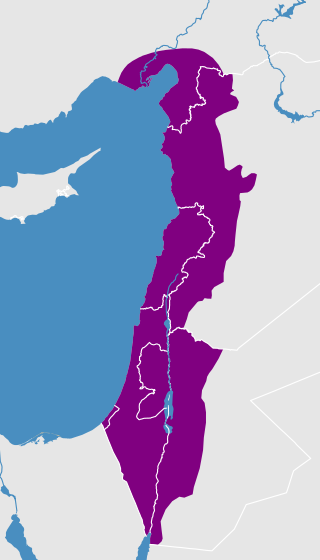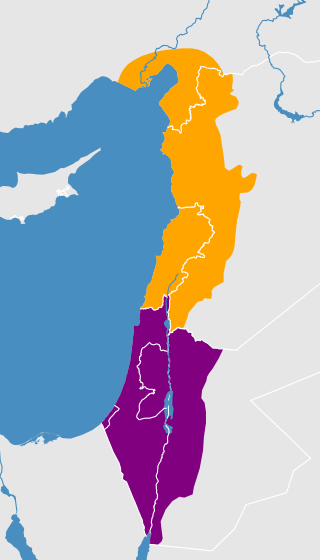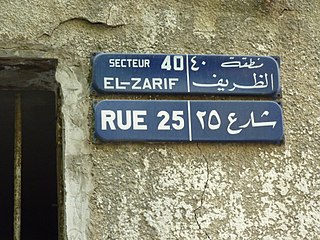
The Levant is an approximate historical geographical term referring to a large area in the Eastern Mediterranean region of West Asia and core territory of the political term Middle East. In its narrowest sense, which is in use today in archaeology and other cultural contexts, it is equivalent to Cyprus and a stretch of land bordering the Mediterranean Sea in western Asia: i.e. the historical region of Syria, which includes present-day Israel, Jordan, Lebanon, Syria, the Palestinian territories and most of Turkey southwest of the middle Euphrates. Its overwhelming characteristic is that it represents the land bridge between Africa and Eurasia. In its widest historical sense, the Levant included all of the Eastern Mediterranean with its islands; that is, it included all of the countries along the Eastern Mediterranean shores, extending from Greece in Southern Europe to Cyrenaica, Eastern Libya in Northern Africa.

Levantine Arabic, also called Shami, is an Arabic variety spoken in the Levant: in Syria, Jordan, Lebanon, Palestine, Israel, and southern Turkey. With over 54 million speakers, Levantine is, alongside Egyptian, one of the two prestige varieties of spoken Arabic comprehensible all over the Arab world.

Lebanese Arabic, or simply Lebanese, is a variety of North Levantine Arabic, indigenous to and primarily spoken in Lebanon, with significant linguistic influences borrowed from other Middle Eastern and European languages and is in some ways unique from other varieties of Arabic. Due to multilingualism and pervasive diglossia among Lebanese people, it is not uncommon for Lebanese people to code-switch between or mix Lebanese Arabic, French, and English in their daily speech. It is also spoken among the Lebanese diaspora.

Arabic is the official language of Syria and is the most widely spoken language in the country. Several modern Arabic dialects are used in everyday life, most notably Levantine in the west and Mesopotamian in the northeast.

Syrians are the majority inhabitants of Syria, indigenous to the Levant, who have Arabic, especially its Levantine dialect, as a mother tongue. The cultural and linguistic heritage of the Syrian people is a blend of both indigenous elements and the foreign cultures that have come to rule the land and its people over the course of thousands of years. By the seventh century, most of the inhabitants of the Levant spoke Aramaic. In the aftermath of the Muslim conquest of the Levant in 634, Arabic became the dominant language, but a minority of Syrians retained Aramaic, which is still spoken in its Syriac and Western dialects.
North Levantine Arabic was defined in the ISO 639-3 international standard for language codes as a distinct Arabic variety, under the apc code. It is also known as Syro-Lebanese Arabic, though that term is also used to mean all of Levantine Arabic.

Jordanian Arabic is a dialect continuum of mutually intelligible varieties of Arabic spoken by the population of the Hashemite Kingdom of Jordan.
Liu is a common Chinese surname.
قلب, transliterated Qalb, Qlb and Alb, is a functional programming language allowing a programmer to write programs completely in Arabic. Its name means "heart" in Arabic and is a recursive acronym for Qlb: a programming language. It was developed in 2012 by Ramsey Nasser, a computer scientist at the Eyebeam Art + Technology Center in New York City, as both an artistic endeavor and as a response to the Anglophone bias in the vast majority of programming languages, which express their fundamental concepts using English words.
The Arab sign-language family is a family of sign languages spread across the Arab Middle East. Its extent is not yet known, because only some of the sign languages in the region have been compared.
Libyan Sign Language is the deaf sign language of Libya. It appears to belong to the Arab sign language family.
Iraqi Sign Language is the deaf sign language of Iraq. It appears to be close to Levantine Arabic Sign Language the common sign language of Lebanon, Palestine, Syria, and Jordan. It is taught in seven schools or deaf associations in the capital of Baghdad and 5 other cities.

Palestinian Arabic is a dialect continuum of mutually intelligible varieties of Levantine Arabic spoken by most Palestinians in Palestine, Israel and in the Palestinian diaspora.
Syrian Arabic refers to any of the Arabic varieties spoken in Syria, or specifically to Levantine Arabic.

Al-Isharat wa’l-tanbihat is apparently one of the last books of Avicenna which is written in Arabic.
This article is about the phonology of Levantine Arabic also known as Shāmi Arabic, and its sub-dialects.
Kafr Qasem Sign Language is a village sign language at Israel.

Damascus Arabic or Damascus Dialect is a North Levantine Arabic spoken dialect, indigenous to and spoken primarily in Damascus. As the dialect of the capital city of Syria, and due to its use in the Syrian broadcast media, it is prestigious and widely recognized by speakers of other Syrian dialects, as well as in Lebanon, Palestine, and Jordan. Accordingly, in modern times it is sometimes known as Syrian Arabic or the Syrian Dialect; however, the former term may also be used to refer to the group of similar urban sedentary dialects of the Levant, or to mean Levantine Arabic in general.
Levantine Arabic vocabulary is the vocabulary of Levantine Arabic, the variety of Arabic spoken in the Levant.

Most people in Lebanon speak the Lebanese variety of Levantine Arabic, but Lebanon's official language is Modern Standard Arabic (MSA); French is also recognized, and is used alongside MSA on road signs and Lebanese banknotes. Lebanon's native sign language is the Lebanese dialect of Levantine Arabic Sign Language. English is the fourth language by number of users, after Levantine, MSA, and French. Most Armenians in Lebanon can speak Western Armenian, and some can speak Turkish. Syriac Aramaic is also spoken as a first language in some Lebanese communities such as Syriac Catholics, Syriac Orthodox and Assyrian Lebanese. It is also used in liturgies in other communities such as Maronite Catholics.









